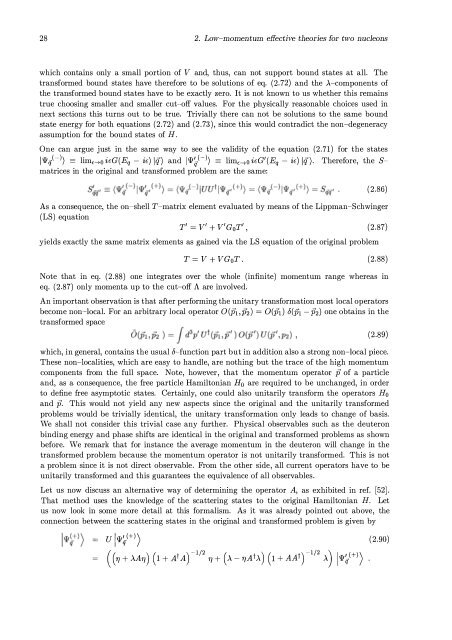The Nucleon-Nucleon Interaction in a Chiral Effective Field Theory
The Nucleon-Nucleon Interaction in a Chiral Effective Field Theory
The Nucleon-Nucleon Interaction in a Chiral Effective Field Theory
Create successful ePaper yourself
Turn your PDF publications into a flip-book with our unique Google optimized e-Paper software.
28 2. Low-momentum efIective theories for two nucleons<br />
which conta<strong>in</strong>s only a small portion of V and, thus, can not support bound states at all. <strong>The</strong><br />
transformed bound states have therefore to be solutions of eq. (2.72) and the 'x-components of<br />
the transformed bound states have to be exactly zero. It is not known to us whether this rema<strong>in</strong>s<br />
true choos<strong>in</strong>g sm aller and sm aller cut-off values. For the physically reasonable choices used <strong>in</strong><br />
next seetions this turns out to be true. Trivially there can not be solutions to the same bound<br />
state energy for both equations (2.72) and (2.73), s<strong>in</strong>ce this would contradict the non-degeneracy<br />
assumption for the bound states of H.<br />
One can argue just <strong>in</strong> the same way to see the validity of the equation (2.71) for the states<br />
Iwq(-)) == limHo ifG(E q - if) Iq) and Iwif(-)) == limt----to ifG'(E q - if) Iq). <strong>The</strong>refore, the Smatrices<br />
<strong>in</strong> the orig<strong>in</strong>al and transformed problem are the same:<br />
(2.86)<br />
As a consequence, the on-shell T-matrix element evaluated by means of the Lippman-Schw<strong>in</strong>ger<br />
(LS) equation<br />
T' = V' + V'GoT' , (2.87)<br />
yields exactly the same matrix elements as ga<strong>in</strong>ed via the LS equation of the orig<strong>in</strong>al problem<br />
T = V + VGoT . (2.88)<br />
Note that <strong>in</strong> eq. (2.88) one <strong>in</strong>tegrates over the whole (<strong>in</strong>f<strong>in</strong>ite) moment um range whereas <strong>in</strong><br />
eq. (2.87) only momenta up to the cut-off A are <strong>in</strong>volved.<br />
An important observation is that after perform<strong>in</strong>g the unitary transformation most local operators<br />
become non-Iocal. For an arbitrary local operator O(ih,ih) = O(pd 8(Pl -P2) one obta<strong>in</strong>s <strong>in</strong> the<br />
transformed space<br />
(2.89)<br />
which, <strong>in</strong> general, conta<strong>in</strong>s the usual 8-function part but <strong>in</strong> addition also a strong non-Iocal piece.<br />
<strong>The</strong>se non-Iocalities, which are easy to handle, are noth<strong>in</strong>g but the trace of the high momentum<br />
components from the full space. Note, however, that the momentum operator P of a particle<br />
and, as a consequence, the free particle Hamiltonian Ho are required to be unchanged, <strong>in</strong> order<br />
to def<strong>in</strong>e free asymptotic states. Certa<strong>in</strong>ly, one could also unitarily transform the operators Ho<br />
and p. This would not yield any new aspects s<strong>in</strong>ce the orig<strong>in</strong>al and the unitarily transformed<br />
problems would be trivially identical, the unitary transformation only leads to change of basis.<br />
We shall not consider this trivial case any furt her. Physical observables such as the deuteron<br />
b<strong>in</strong>d<strong>in</strong>g energy and phase shifts are identical <strong>in</strong> the orig<strong>in</strong>al and transformed problems as shown<br />
before. We remark that for <strong>in</strong>stance the average momentum <strong>in</strong> the deuteron will change <strong>in</strong> the<br />
transformed problem because the moment um operator is not unitarily transformed. This is not<br />
a problem s<strong>in</strong>ce it is not direct observable. From the other side, all current operators have to be<br />
unitarily transformed and this guarantees the equivalence of all observables.<br />
Let us now discuss an alternative way of determ<strong>in</strong><strong>in</strong>g the operator A, as exhibited <strong>in</strong> ref. [52J.<br />
That method uses the knowledge of the scatter<strong>in</strong>g states to the orig<strong>in</strong>al Hamiltonian H. Let<br />
us now look <strong>in</strong> some more detail at this formalism. As it was already po<strong>in</strong>ted out ab ove , the<br />
connection between the scatter<strong>in</strong>g states <strong>in</strong> the orig<strong>in</strong>al and transformed problem is given by<br />
u Iwif(+))<br />
(2.90)<br />
((1J + ,XA1J) (1 +AtA)- 1 /2 1J+ ('x- 1JAt,X) (1+AAt)-1 /2 ,X) Iwif(+))












